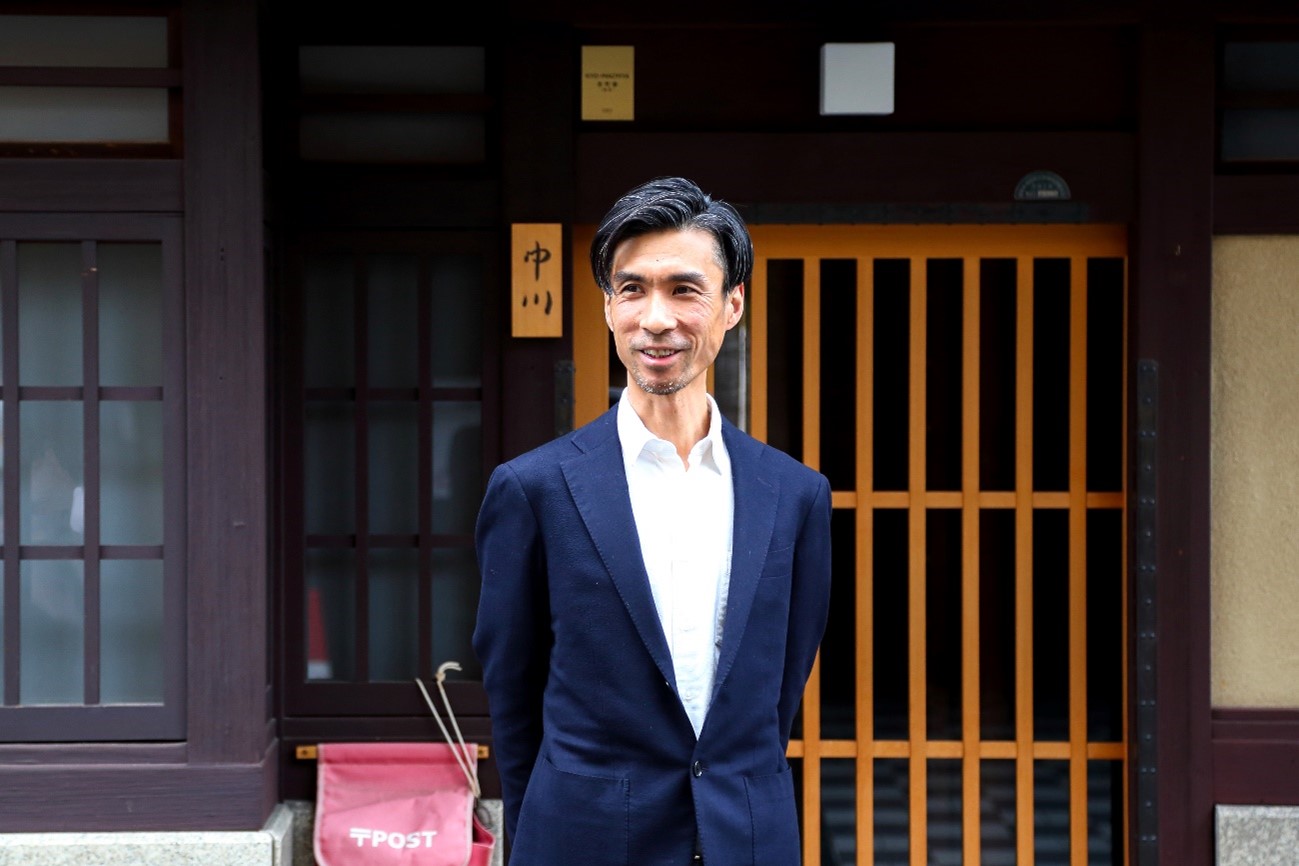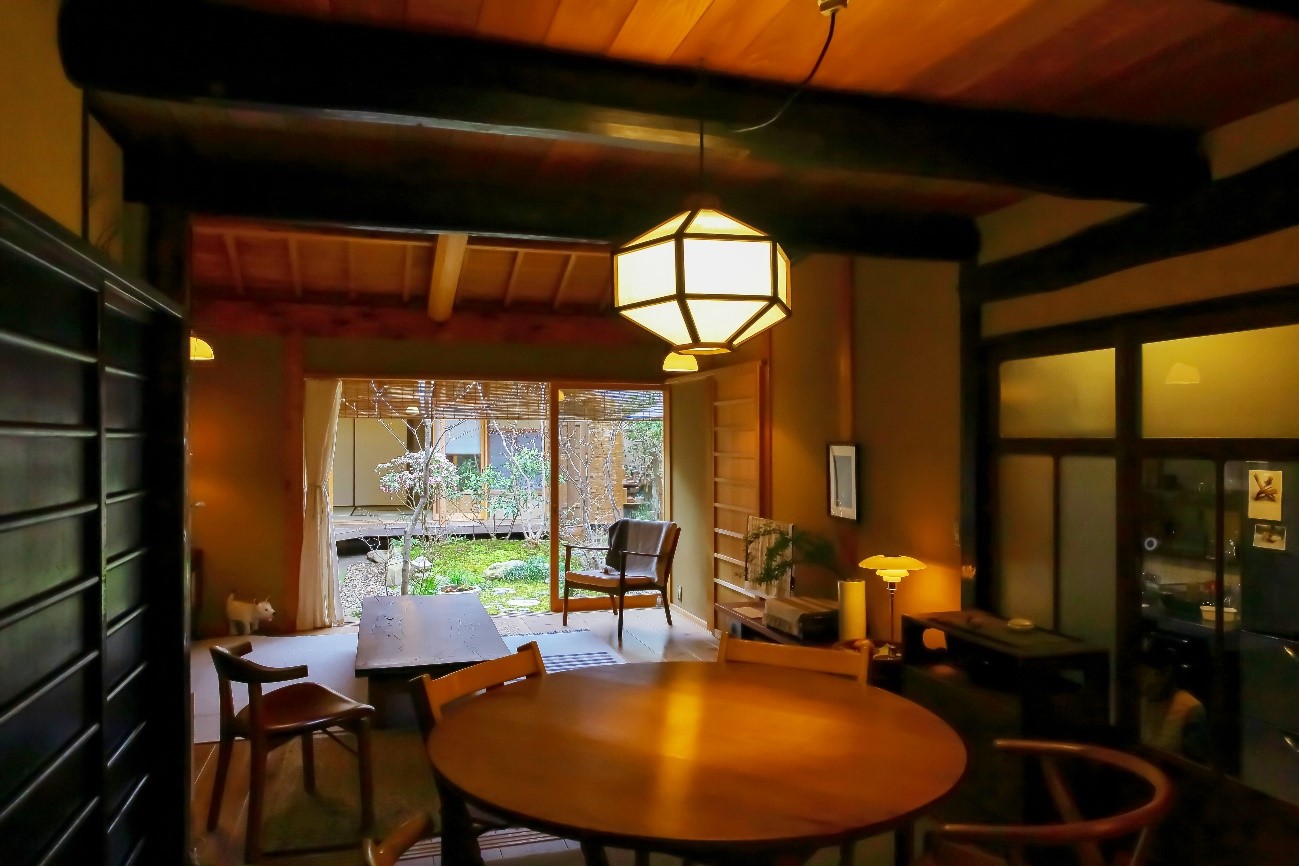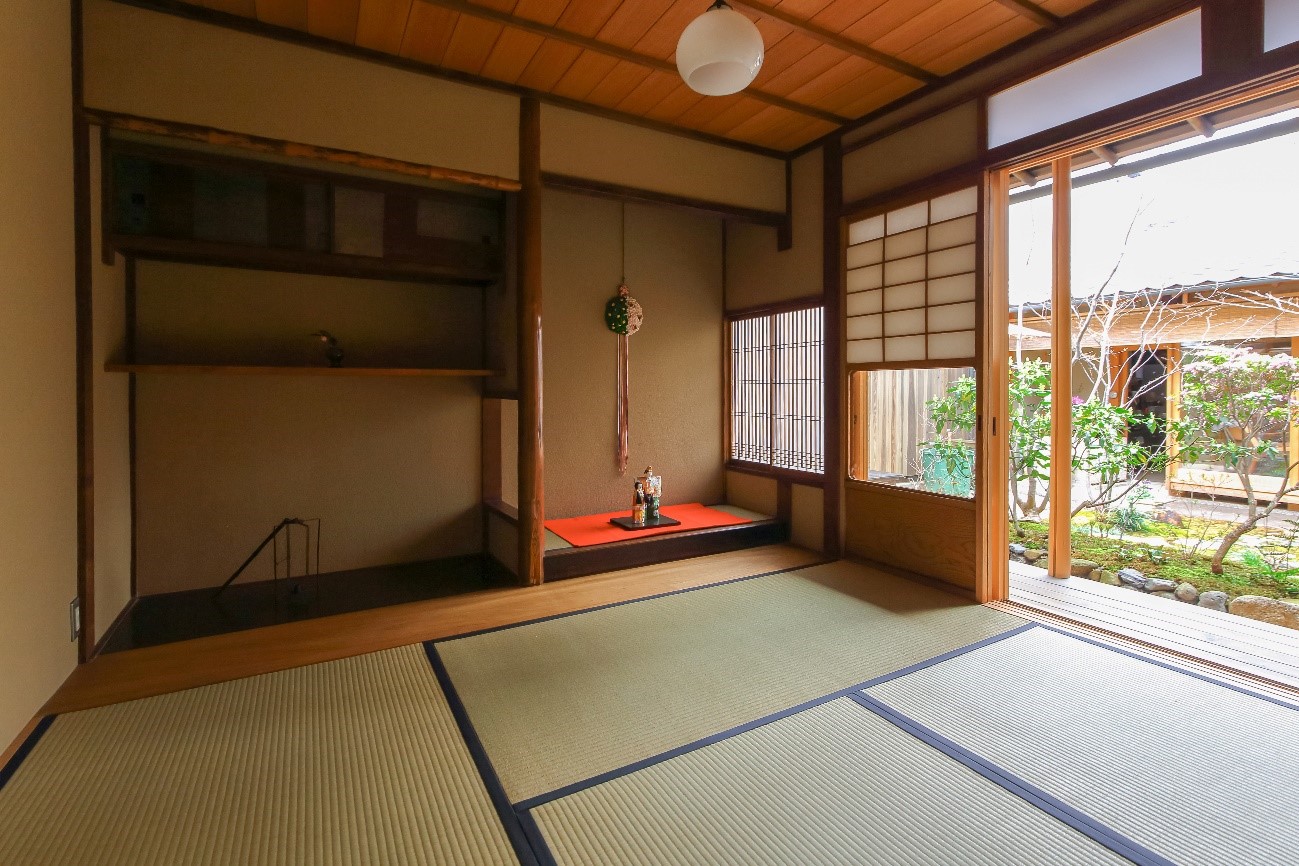
There are various Kyo-machiya townhouses with different floor plans and designs depending on their backgrounds and types of family businesses engaged there. Mr. Koji Nakagawa, the representative of Koji Nakagawa Architect Office, has renovated a Kyo-machiya townhouse in oriyadate* structure with optimum features for weaving to the space for his office as well as his residence. We interviewed him on his thoughts on the Kyo-machiya townhouse and his passion on its architecture.
* A type of Kyo-machiya townhouses frequently found in the Nishijin area where a lot of textile manufacturers used to be. Its use of the spaces in the front and the back is different from that of the normal Kyo-machiya townhouse: the living space in the front and the working space in the back.
Profile of the Kyo-machiya townhouse
The Kyo-machiya townhouse built in oriyadate structure with its record showing that it was built in 1877. It was renovated in 2016 with the support of Kyoto Machiya Machizukuri Fund managed by the Kyoto Center for Community Collaboration (the KCCC). Since then, Mr. Nakagawa, the owner of the house, has continued its repairs on the detached house and the connecting corridor etc., and uses the building both for his work and living. It is the designated Kyo-machiya townhouse under the city ordinance on Kyo-machiya.
Koji Nakagawa
Having graduated in 2002 from the Department of Architecture, the College of Art and Design, Musashino Art University, Nakgawa worked at an architectural office and in 2014 he established Koji Nakagawa Architect Office with the first class registered architect license. Currently he works also as a cultural heritage manager (in charge of architecture) for Kyoto city.
Encounter with a Kyo-machiya townhouse in Nishijin
Mr. Nakagawa’s Kyo-machiya is in the area, so-called “Nishijin” in Kamigyo-ku, whose area is known for Nishijin Textile, and there used to be many townhouses for the twisters of thread and the weavers. However, as the time passes, many have discontinued their businesses, and the townhouses used as textile factories as well as residences are not needed any longer, and some were demolished. His Kyo-machiya townhouse, also built originally as a textile factory, was put for sale on a real-estate leaflet as “the land with an old house,” which Mr. Nakagawa saw by chance.

|
| In Kyoto, since there are still many historical buildings such as Kyo-machiya townhouses, one could find various clues for new designs if he/she goes out for a walk in the neighborhood. The mushiko-mado window which Mr. Nakagawa found during his walk was incorporated in his own Kyo-machiya townhouse when it was renovated. |
Mr. Nakagawa was born in Fukuchiyama City, Kyoto Prefecture, and raised in a Machiya townhouse in a castle town. His parents ran a pharmacy, and it was natural for him to live in the space both for work and residence. When he was a student, he traveled around the world as a backpacker. Then what most attracted him was not famous architectural buildings nor tourist sites, but the street space along the normal streets where he could feel the actual living of the local people. Those energetic local people and buildings he encountered there attracted him very much. In Japan, there used to be many fascinating streets like such streets, and he started to desire not to lose them, and to preserve Kyo-machiya townhouses and the streetscapes which are the important elements to the streets. Furthermore, since he had learned at the university not to plan any new buildings over demolished old ones but to plan a building on the assumption not to demolish any, he as an architect cherishes the idea “to make some additions for a comfortable living without demolishing a building.”

|
| Mr. Nakagawa talking about his thoughts on Kyo-machiya townhouses and his passion in the architecture. |
Renovation treasuring the background of the building
Having graduated from the university, Mr. Nakagawa worked in Tokyo for a while and then selected Kyoto as the place where he works independent. There are many historical buildings including temples, shrines, and long-time establishments as well as Kyo-machiya townhouses in Kyoto, and the quality of the craftsperson’s’ techniques as well as of the materials for wooden buildings are very high, which are all linked to Mr. Nakagawa’s idea to carefully preserve buildings without demolishing. Since the house where he spent his childhood was a co-space for work and living, he sought for the place both for his office and his residence from the beginning. When he was searching for a location where it is calm but possible to have a close contact with the local community, he found his current Kyo-machiya townhouse. Mr. Nakagawa says, “This Kyo-machiya townhouse, built sometime before the end of Meiji era, has many things I looked for including the entrance open to the north and a garden, etc. Furthermore, I was already familiar with the area because one of my relatives had lived in the neighborhood.” He added, “While I started to know more about the values of the Kyo-machiya townhouse, I started to realize its negative images like coldness, hotness, and inconvenience, which might be the reasons for frequent pull-downs of Kyo-machiya townhouses in the neighborhood. Not to induce any further demolition, I strongly wished to show a good example of improvements on the Kyo-machiya for its more comfortable life.” However, this Kyo-machiya townhouse had not been maintained at all for a long time and the awful damages caused by the rain leak required a large-scale restoration.

|
| The space of architect office and residence, which Mrs. Nakagawa sometimes uses as the atelier for her class. |
Mr. Nakagawa mentions that understanding the building’s history and knowing its backgrounds and reasons why it was built there would help him to reflect its maximum potentiality in its renovation plan. For example, according to the close check on its register as well as the fact that a natural log is used as the beam of the main house, it was found that this townhouse was built in the beginning of Meiji era or in the end of Edo period for rent to the common people. Its Japanese-style tatami room was created by adding a floor, a wall, and a ceiling at the space where there used to be a spacious doma earthen-floored place with a vaulted ceiling. Mr. Nakagawa says that he restored the original vaulted ceiling which is a characteristic of oriyadate structure to make his Kyo-machiya townhouse more attractive. He considers it very important not only to repair the damaged parts of the structure but also to add some improvements such as heat insulation for better living.

|
| The two beams hung over the wall between okuno-ma back room and the tori-niwa passage show us that there used to be no dividing wall but a very spacious doma earthen-floored space unique to oriyadate structure. |
The combined space for work and living to experience good ways and means for life
A garden where the rhythm of nature and the change of seasons could be felt is an extremely important element for the life in the city densely surrounded by buildings. It helps more sunlight to come in and improves ventilation. Furthermore, it increases the time to contact with the nature; enjoying a cup of tea sitting on the veranda and pulling weeds, which could heal mind and body. In this regard, Mr. Nakagawa recommends his clients to create a garden in their houses.

|
| The water, still sprung out from the well, is used for watering the garden. |
“It is not to change the building depending on the necessity of one’s life, but it might be important to live according to the structure of the building,” said Mr. Nakagawa.
For example, the Kyo-machiya townhouse which is famous for its hotness in summer and coldness in winter could be turned into a very comfortable space, if one could make additional arrangements over the openings such as installing sliding paper-screens inside of the glass doors. Such arrangements could be easily shown to his clients because of the integrated space for work and living. Mr. Nakagawa says, “Because I was raised in the space both for work and living and I also wished to spend time with my children, I created the space for my office and my residence together. Since this Kyo-machiya townhouse was originally built as an integrated space for work and living, my current lifestyle may match with the original purpose of this townhouse.”

|
| The space right after the entrance is the office. Many books on architecture are filling the bookshelves. |
Living in a Kyo-machiya townhouse is to hand DNA over to the future
Mr. Nakagawa tells that a Kyo-machiya townhouse, different from a newly built house, is filled with the charms to be handed over to next generations even if it was built by somebody else. “A Kyo-machiya townhouse with a long history has gradually formed its style over years. During the time, good and bad repair works have been done. In many cases, things made in the past are well-made, which is the positive point on the lapse of time. Such fascinating point is the attractiveness, different from the newly built house.”
Continually using a Kyo-machiya townhouse by making necessary repairs is connected to handing its DNA over to the next generation. Our planting a seed in a townscape enables us to restore a Kyo-machiya townhouse even 100 years later.”

|
| The detached tatami room, whose renovation work has completed in March 2023. A seasonal decoration is displayed on the tokonoma alcove. This room could be also used as a tea room. |
At this Kyo-machiya townhouse, the tataki earth-clay floor in the garden was made by pounding the shifted earth in the garden. The walls of a connecting corridor were re-done by kneading the earth of the original wall pulled down. The stones in the garden have been repositioned. And the main materials of the tokonoma alcove in the detached tatami room are from the alcove in the main house built in the Meiji era. Old materials were reused as much as possible if any attractiveness and potentiality were found in them. It is amazing to find how well the rare sustainable approach minimizing the industrial waste is enabled in terms by such excellent materials and technology. Utilizing the original materials and making the most of them according to the original features of the Kyo-machiya townhouse could surely leads to a proper preservation of Kyo-machiya townhouse to the future.

|
| The wall of the connecting corridor repaired with the reused earth from the other pull-down. |

